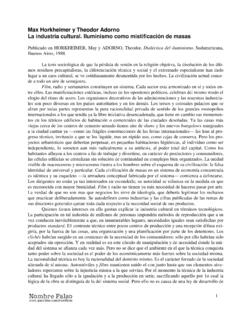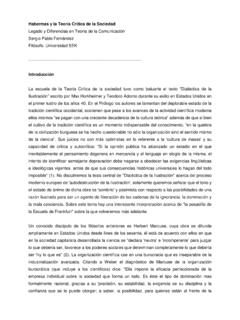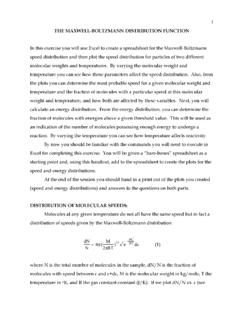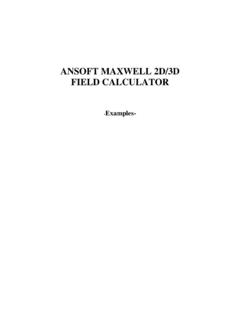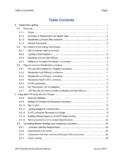Transcription of The Agenda-Setting Role of the Mass Media
1 The Agenda-Setting Role of the Mass Media in the Shaping of Public Opinion maxwell McCombs University of Texas at Austin The power of the news Media to set a nation s agenda , to focus public attention on a few key public issues, is an immense and well-documented influence. Not only do people acquire factual information about public affairs from the news Media , readers and viewers also learn how much importance to attach to a topic on the basis of the emphasis placed on it in the news. Newspapers provide a host of cues about the salience of the topics in the daily news lead story on page one, other front page display, large headlines, etc. Television news also offers numerous cues about salience the opening story on the newscast, length of time devoted to the story, etc. These cues repeated day after day effectively communicate the importance of each topic.
2 In other words, the news Media can set the agenda for the public s attention to that small group of issues around which public opinion forms. The principal outlines of this influence were sketched by Walter Lippmann in his 1922 classic, Public Opinion, which began with a chapter titled The World Outside and the Pictures in Our Heads. As he noted, the news Media are a primary source of those pictures in our heads about the larger world of public affairs, a world that for most citizens is out of reach, out of sight, out of mind. 1 What we know about the world is largely based on what the Media decide to tell us. More specifically, the result of this mediated view of the world is that the priorities of the Media strongly influence the priorities of the public. Elements prominent on the Media agenda become prominent in the public mind.
3 Social scientists examining this Agenda-Setting influence of the news Media on the public usually have focused on public issues. The agenda of a news organization is found in its pattern of coverage on public issues over some period of time, a week, a month, an entire year. Over this period of time, whatever it might be, a few issues are emphasized, some receive light coverage, and many are seldom or never mentioned. It should be noted that the use of term agenda here is purely descriptive. There is no pejorative implication that a news organization has an agenda that it relentlessly pursues as a premeditated goal. The Media agenda presented to the public results from countless day-to-day decisions by many different journalists and their supervisors about the news of the moment.
4 The public agenda the focus of public attention is commonly assessed by public opinion polls that ask some variation of the long-standing Gallup Poll question, What is the most important problem facing this country today? . Comparisons of the Media agenda in the weeks preceding these opinion polls measuring the public agenda yield significant evidence of the Agenda-Setting role of the news Media . When Chapel Hill, North Carolina, voters were asked to name the most 2important issues of the day in the very first empirical study of this Agenda-Setting influence their responses closely reflected the pattern of news coverage during the previous month in the mix of newspapers, network television news, and news magazines available to Since that initial study during the 1968 presidential election, more than 300 hundred published studies worldwide have documented this influence of the news Media .
5 It should be noted that this evidence encompasses a wide variety of research designs, including numerous panel studies, time-series analyzes, and controlled laboratory experiments. To summarize the extent of this influence and to facilitate comparisons from one research setting to another social scientists frequently calculate the correlation between the ranking of issues on the Media agenda and the ranking accorded those same issues on the subsequent public agenda . This quantitative measure provides a substantial degree of precision for our comparisons, much as a thermometer s precise numbers are better than simply saying it seems cooler today than it was yesterday. The vast majority of comparisons between how issues are ranked on the Media agenda and how the public ranks the importance of these same issues yield correlations of +.
6 50 or That reflects a substantial degree of influence. The original study of the Agenda-Setting influence of the news Media , which was conducted in Chapel Hill, examined a month during that 1968 presidential election. Subsequent studies have examined much longer periods of time for example, a year-long, nine-wave panel study during the 1976 presidential election 4 and found similar evidence of strong Agenda-Setting effects among the public. A look at the entire decade of the 1960s found a substantial correlation (+.78) between the patterns of 3coverage in news magazines and the trends in public opinion reflected by responses to the Gallup Poll s question about the most important problem facing the Agenda-Setting effects also have been found at the local level, and the evidence for both national and local effects is found in a wide variety of settings around the world.
7 In Spain, unemployment and urban congestion were the major concerns of Pamplona, Spain, residents in the spring of 1995. Comparisons of all six major concerns on the public agenda with local news coverage in the preceding two weeks found a high degree of correspondence. The match with the dominant local daily newspaper was +.90; with the second Pamplona daily, +.72; and with television news, +. Agenda-Setting at the community level also occurred in a 1986 Japanese mayoral Voters in Machida City, a municipality of 320,000 residents in the Tokyo metropolitan area, regarded welfare policies, urban facilities, and local taxes as the three most important issues in the election. Comparison of the public agenda , which had seven issues in all, with the coverage across a three-week period of the four major newspapers serving Machida City yielded a modest, but positive, correlation of +.
8 39. In Argentina, Agenda-Setting effects were found in the 1997 legislative elections in the Buenos Aires metropolitan Corruption was prominent on both the public and Media agendas throughout the fall, always ranking first or second. But in September there was only modest overall agreement (+.43) between the public agenda and the combined issue agenda of five major Buenos Aires newspapers. However, as election day approached in October, the correspondence between the agendas soared to +.80, an increase that suggests considerable learning from the news Media in the closing weeks of the election campaign. 4 Returning to the national level, in the during the final decade of the 20th century (1990-2000) there was significant correspondence (+.54) between public concern about international issues and the pattern of international coverage in The Times.
9 9 In sum, the news Media have a substantial influence on the content of the public agenda , and the phrase setting the agenda has become commonplace in discussions of journalism and public opinion. Influencing the pictures in our heads The Agenda-Setting influence of the news Media is not limited to this initial step of focusing public attention on a particular topic. The Media also influence the next step in the communication process, our understanding and perspective on the topics in the news. If you think about the agenda in abstract terms, the potential for a broader view of Media influence on public opinion becomes very clear. In the abstract, the items that define the agenda are objects. For all the agendas we have discussed, the objects are public issues, but they could be other items or topics, such as the agenda of political candidates during an election.
10 The objects are the things on which the attention of the Media and the public are focused. In turn, each of these objects has numerous attributes, those characteristics and traits that describe the object. For each object there also is an agenda of attributes because when the Media and the public think and talk about an object, some attributes are emphasized, others are given less attention, and many receive no attention at all. This agenda of attributes is another aspect of the Agenda-Setting role of the news Media . 5 To borrow Walter Lippmann s phrase, the pictures in our heads, the agenda of issues or other objects presented by the news Media influence what the pictures in our heads are about. The agenda of attributes presented for each of these issues, public figures, or other objects literally influences the pictures themselves that we hold in mind.
